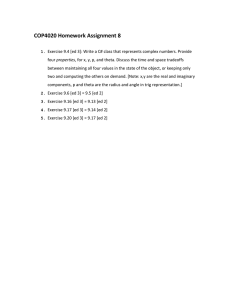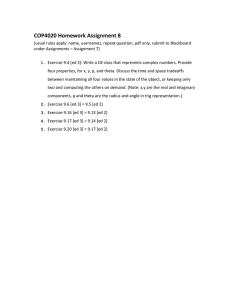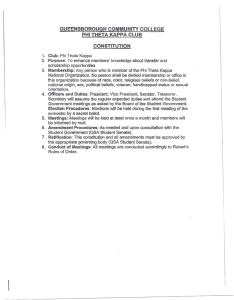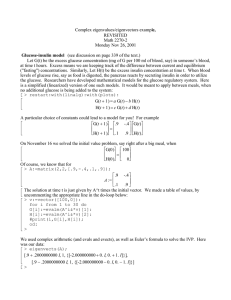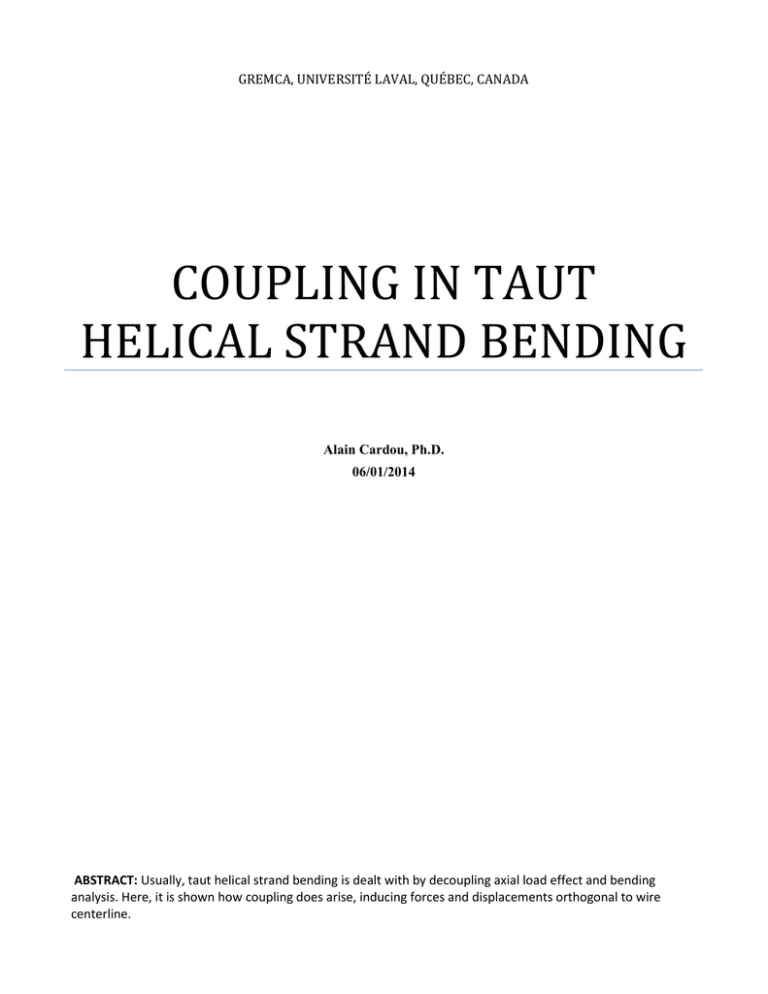
GREMCA, UNIVERSITÉ LAVAL, QUÉBEC, CANADA
COUPLING IN TAUT
HELICAL STRAND BENDING
Alain Cardou, Ph.D.
06/01/2014
ABSTRACT: Usually, taut helical strand bending is dealt with by decoupling axial load effect and bending
analysis. Here, it is shown how coupling does arise, inducing forces and displacements orthogonal to wire
centerline.
Copyright © by Alain Cardou
All rights reserved
COUPLING IN TAUT HELICAL STRAND BENDING
By Alain Cardou, Ph.D.
1.
INTRODUCTION
Usually, taut helical strand bending is dealt with by decoupling axial load effect and bending analysis
(Costello, 1997; Feyrer, 2007). For example, in stick-slip models (e.g. Papailiou, 1995), axial load
intervenes through inter-layer pressure. Then, bending analysis is performed assuming that this
pressure component does not vary (although local pressure is affected by the bending process).
Lanteigne’s model (1985), with its stiffness matrix, is another example of such decoupling. The
objective of this note is to show that there is indeed some coupling, albeit small
This effect arises from the fact that the circular helix, which defines a wire centerline in the zero
curvature state, is transformed into another curve, which is not a geodesic curve, on the deformed lay
cylinder. Here it will be assumed, as in most reports, that lay cylinder is given a uniform curvature, thus
becoming a torus. The circular helix is mapped into a toroidal helix, which is not a torus geodesic
curve, contrary to some authors’ assumption (e.g. Baticle, 1912). This fact has already been studied by
Leider (1977), who concentrated mainly on wire curvature evaluation and its effect on bending stress.
2.
GEOMETRIC PROPERTIES OF THE TOROIDAL HELIX CURVE
z
R
O
C0
r
P
ϕ
C
P0
y
θ
x
Figure 1
The torus in Fig. 1 is a 3D surface defined using two parameters (,) by the following equations:
x( , )
R
r cos
y( , )
R
r cos sin
z( , )
r sin
-1-
cos
(1)
The curves
cst are its parallels, circles centered on the z-axis. The curves
cst are its meridians,
circles of constant radius r, centered on the torus centerline. A curve on this surface may be defined by
some relationship () between both parameters. The simplest one, similar to the usual helix, is the
linear relationship
(2)
k
This particular curve has been called a «toroidal helix» by William Thomson1 also known as Lord
Kelvin. It is interesting to study some of its properties, in particular the angle it makes with the
parallels, its principal radius of curvature, and the orientation of its principal normal (in its osculating
plane) with respect to the normal to the torus. Thus, one needs the first and second derivatives with
respect to the single parameter . These derivatives are noted (x, y, z) and (x, y, z) :
x( )
y( )
(R
(R
r cos k )sin
r cos k ) cos
ak sin k cos
ak sin k sin
z( )
ak cos k
x( )
(R
r cos k ) cos
2rk sin k sin
rk 2 cos k cos
y( )
(R
r cos k )sin
2rk sin k cos
rk 2 cos k sin
z( )
2
(3)
(4)
rk sin k
The position vector of any point P on the curve is rP
xi
yj
zk where (i, j, k) are the unit vectors
on the reference axes. The unit tangent vector t to the curve is given by: drP ds , that is, its derivative
with respect to the curvilinear abscissa s of point P on the curve. Thus:
drP
ds
t
xi
yj
(5)
zk
where (x , y , z ) are derivatives with respect to s. Unit tangent vector t may also be expressed in
terms of the (x, y, z) derivatives as:
t
xi
yj
zk
d
ds
(6)
Since t is a unit vector:
t
2
1
x
1
2
y
2
z
2
d
ds
2
(7)
“This curve I call a toroidal helix, because it lies on a toroid just as the common regular helix lies on a circular cylinder”
William Thomson, Vortex Statics, Proc. of the Royal Soc. of Edinburgh, Vol. IX, No 94, 1875-76, p.63.
-2-
from which the
d
ds derivative is obtained:
d
ds
1
x2
y2
(8)
z2
The plus sign has been selected, meaning that s increases as increases.
Angle with torus parallel circles
The tangent unit vector to parallel circle at point P is given by`:
e
sin i
cos j
(9)
The angle between vectors t and e is given by
cos
t e
R
r cos k
d
ds
(10)
and it is obvious that it is not a constant, in contradistinction with the usual circular helix.
Example 1
Consider a circular helix. The cylinder radius is r = 20 mm. The helix angle is 75° or, using the
conductor terminology, the lay angle is
90 75 15 deg. Its pitch length is
h 2 r tan
468.98 mm . Next, consider a torus whose centerline radius is R = 1000 mm and
meridian circle radius is again r = 20 mm. It is defined by parameters (,) as in Fig. 1. A toroidal helix
starts at point (0,0). In the linear relationship
k , constant k is calculated in such a way that the
line passes through point (1, 2) where 1 is such that the arc length on the centerline is
R
1
h
468.98 mm . Thus,
1
0.46898 rad . Constant k is given by k
1
2
0.074641 . With
these parameters, plot the variation of angle with respect to on the [0,2] interval.
This is done with the Matlab function Example_1 (script file in Appendix B)
It is found that angle is exactly 15° for
90 deg. and
270 deg. , that is with parallel circles with
radius R (points on the neutral axis if the torus is considered as a bent circular section rod). Angle is
slightly smaller (14.7°) on the outer parallel circle (radius R+r) and slightly greater on the inner parallel
circle (radius R-r). If radius R is decreased, say to 200 mm, it is found that the variation increases.
Osculating plane and maximum curvature
At a given point P of a regular space curve (such as the circular or toroidal helices), one defines the
osculating plane to the curve, which is the limit to a plane passing by three neighbouring points P’,P
-3-
and P”, as P’ and P” tend towards P. In this plane, a unit vector n is defined at P, normal to the tangent
vector t . It is usually taken positive pointing to the concave side. Also, a third unit vector b is defined
by b t n . It is of course normal to the osculating plane, and is called the binormal unit vector. The
(t, n, b) is the Serret-Frenet trihedron at point P.
Variation of these vectors, as P moves along the curve, are (dt ds,dn ds,db ds) . These derivatives
with respect to the curvilinear abscissa s of point P are given by the well-known Serret-Frenet
equations. For a regular space curve, they are recalled below:
dt
ds
dn
ds
n
t
b
db
ds
(11)
n
where is the curvature and is the torsion of the curve at point P. In the osculating plane, an
osculating circle to the curve at P is defined as follows. Its radius is
1 , and it is centered at point
CP located on the straight line defined by n , in the concave side of the curve. Its unit tangent vector is
the same vector t as for the space curve.
For the circular helix, radius R and helix angle , whose cylinder axis is z, the osculating plane at any
point P makes a constant angle
torsion is
cos2 R .
sin 2
with the z-axis and the curvature is
2
R and the
For the toroidal helix, in order to determine the curvature , the first of Eqs 11 has to be used.
dt
ds
n
dt d
d ds
(12)
that is:
n
xi
yj
d
zk
ds
2
xi
d2
zk
ds 2
yj
(13)
After regrouping the terms, the three components of vector n are:
x
2
x
ny
y
2
y
nz
z
2
z
nx
(14)
Thus:
2
x
2
x
2
-4-
y
2
y
2
z
2
z
2
(15)
d
ds
is given by Eq. 8. A second derivation yields
d2
ds 2
xx
x
2
yy
y
d2
ds 2
. It yields
zz d
ds
z
(16)
2 32
2
Eq. 15 may also be expressed under a more compact form (Struik, 1961):
2
rP
rP
rP
rP rP
rP
(17)
3
where the first and second derivatives of vector rP are taken with respect to parameter . Using Eq. 17,
2
may be expressed in terms of the coordinates (x(),y(),z()) as follows:
2
(yz zy) 2
(xz zx) 2 (xy
(x 2 y2 z 2 )3
yx) 2
(18)
It may be checked numerically that Eqs 15 and 16 are indeed identical. Using either of them, radius of
curvature
1 can be obtained (here, it is taken as positive).
Example 2
Consider the outer layer (layer 1) of the Bersimis ACSR conductor (data in Appendix A), plot the
variation of wire centerline radius of curvature with respect to on the [0,2] interval.
Use Matlab function Example_2 (script file in Appendix B)
It is found that varies from 241 mm on the outer parallel circle (radius R+r) to 395 mm on the inner
parallel circle (radius R-r). Compare with the corresponding circular helix, with a constant of about
300 mm.
Angle of the osculating plane with respect to the surface normal vector: geodesics
The osculating plane to the curve is defined by vectors t and n . At point P on the curve, it is also
possible to define a tangent plane to the torus surface as well as a normal unit vector n T . Here, it is
given by:
nT
(cos cos )i
(cos sin ) j
sin k
(19)
Here, its orientation is taken positive pointing to the outside of the torus, which is an arbitrary
convention. In general, this vector makes an angle with the osculating plane. In some cases n T lies in
-5-
the osculating plane to the curve. Then, by definition, the curve is locally a geodesic curve of the
surface.
The circular helix is a typical case: at each point of the curve, the normal vector n T lies in the
osculating plane. In fact, vectors n and n T are parallel. This means that the circular helix is itself a
geodesic curve, with the property that, among all helical paths joining two arbitrary points on a circular
cylinder (there are infinitely many), one of them is the shortest path between these points. If both points
are on the same generator, the shortest path is of course a straight line, which is the limit case of a
circular helix with helix angle of 90°.
For the toroidal helix it is found that n T is generally not in the osculating plane at point P. This may be
seen by studying the angle between the binormal vector b to the curve at point P, which is normal to
the osculating plane (since, by definition, b t n ), and vector n T . When the curve is, locally, in a
geodesic direction, one must have b n T
0 . In principle, the components of b may be obtained
knowing those of t (Eq. 6) and n (Eqs 14). One gets:
3
bx
yz
zy
3
by
xz
(20)
zx
3
bz
xy
yx
They are too unwieldy however, to be written explicitly, in terms of parameter .
Example 3
As in Example 2, consider the outer layer (layer 1) of the Bersimis ACSR conductor, plot the variation
of the absolute value of the scalar product b n T with respect to on the [0,2] interval.
Use Matlab function Example_3 (Appendix B)
It is found that b and n T are orthogonal vectors at points on the curve such that
0, , 2 that is at
points on the outer and inner parallel circles. Thus, at those points, normal vector n T is in the
osculating plane, and the toroidal helix is a geodesic line. However, at any other point, b and n T make
an angle smaller than /2, with a minimum in the vicinity of
2 . In the present case, for this value
of , the angle is about 73°. It is in that region that the toroidal helix deviates the most from the
geodesic line. It is easy to verify that this deviation increases when radius R of the torus decreases.
3.
GEODESIC LINES ON A TORUS
Definition of geodesic lines on a surface
-6-
If one considers two arbitrary points P1 and P2 on the surface, a geodesic line is often defined as the
“line of shortest distance between both points”. This definition is not satisfactory, as can be seen from
the following examples:
On a sphere, it is well known that the geodesic line is an arc of a great circle passing through P1
and P2, that is, the circle defined as the intersection between the sphere and the plane defined by the
three points P1, P2 and the center C of the sphere. However, it is easily seen that there are two arcs
P1P2 , a short one and a long one (except, of course, when P1 and P2 are on the same diameter). Both
arcs are geodesic lines.
On a circular cylinder, assuming P1 and P2 are not on the same generator, any circular helix
joining both points is a geodesic line. However, one of them, which has the largest helix angle,
yields the shortest path between P1 and P2.
Thus, instead of the usual definition, a local definition of a geodesic line is used: it is any line at point P
whose osculating plane contains the normal vector to the surface at point P. Hence, using the above
notation, vectors n T (the surface normal) and n (the line principal normal) must be collinear. From
this condition a second order ordinary differential equation may be found between the two surface
parameters. From the existence theorem for the solutions of ordinary differential equations of the
second order (Struik, 1961):
Through every point of the surface passes a geodesic in every direction
A geodesic is uniquely determined by an initial point and tangent at that point
Geodesic lines on a torus
The second order differential equation simplifies for a surface of revolution and it can be shown that
geodesics of a surface of revolution can be found by quadratures.
Besides, for such surfaces, the following theorem holds, which is due to the French mathematician
Clairaut (Mémoires de l’Académie des Sciences de Paris pour 1733):
When a geodesic line on a surface of revolution makes an angle with the meridian, then along the
geodesic u sin
constant where u is the radius of the parallel.
A torus is of course a surface of revolution. Application of the preceding results to this particular case
yields the following first order equation (Struik, 1961):
crdu
d
u u2
c2 r 2
u
R
(21)
2
in which c is an arbitrary constant and u is the radius of a parallel circle: u
R
r cos for a point P
of coordinates (,) on the torus surface. Eq. 21 may easily be expressed in terms of parameters (,).
-7-
crd
d
(22)
c2
where u is the above function of . Also, the constant c may be
expressed in terms of the angle of a particular geodesic at a point P0
located on the largest parallel circle, radius u R r , and angles
0,
0 . At that point, the geodesic line making an angle 0
with the meridian is selected. Curve element ds has two orthogonal
components on the coordinate lines (Fig. 2) yielding the following
relationship between d and d:
β0
rdθ
(R+r)dϕ
P0
u u2
Figure 2
(R
tan
0
r)d
rd
(23)
that is:
d
d
r
R
r
tan
(24)
0
At P, Eq. 12 yields:
d
d
cr
(R
r) (R
r)2
(25)
c2
Thus, using Eqs 14 and 15, constant c may be expressed in terms of the angle 0 at P0, yielding:
c
(R
r)sin
(26)
0
Hence, it is found that constant c is the one appearing in Clairaut’s theorem. In particular, at point P1
2 , the angle 1 is given by R sin 1 (R r)sin 0 and at point P2 located at 2
located at 1
,
that is on the inner parallel circle, angle 2 is given
P2
ϕ2
(1)
P0
(2)
(3)
by (R
r)sin
2
(R
r)sin
0
.
Now, consider a circular helix, radius r, whose lay
length is h, and assume that, on the torus, point P2
whose parameters are (2, 2) is such that 2
and
R 2 h 2 . This new condition is equivalent to
π
0
π/2
θ
finding the geodesic curve joining points P0 and P2.
The problem reduces to that of finding the particular
Figure 3
value 0 for which the corresponding geodesic curve,
given by Eq. 12, joins these two points. This problem can be solved numerically in the following way.
-8-
Any line on the torus is given by an equation
( ) . Thus it may be represented as a plane curve in
the (,) plane. In Fig. 3, the straight line (1) represents a toroidal helix joining points P0 and P2. Curve
(1) is the geodesic line being sought. If one takes an arbitrary value for 0, the geodesic (3) starting at
P0 does not go through P2 . The problem is to adjust the initial value 0 in order to have the curve pass
through P2. However, from Eq. 22, one has d
f ( ) d , where:
r(R
f( )
(R
r cos ) (R
r)sin
r cos )
0
2
r) 2 sin 2
(R
(27)
0
The quantity under the square root sign must be positive, yielding the condition:
R
(Both quantities are positive since R
r cos
(R
r)sin
r ). Thus,
sin
R
0
r cos
R r
(0
sin
2
0
R
R
(29)
)
. The condition on 0 is:
The minimum value of the right-hand member is obtained for
Or, using
(28)
0
r
r
(30)
, the lay angle, instead of the helix angle:
cos
0
R
R
r
r
(31)
Example 4
Consider again the outer layer (layer 1) of the Bersimis ACSR conductor, find the value of angle 0
such that the geodesic starting at point P0 passes through point P2 ( 2
) and thus, because of the
properties of cos , through point P3 located on the outer parallel circle ( 3 2 ) (one full turn). Note
that, in this case, the shortest path between P0 and P3 is in fact the arc P0 P3 on that circle (radius R+r).
Use Matlab file Example_4 (Appendix B)
In this file, differential Eq. 12 is replaced by the finite difference equation
With r = 20mm and R = 1000 mm, condition 30 yields 0 16.0989 deg.
-9-
f( )
.
The iteration process is controlled by the user based on Figure 1 of the Matlab file output. Starting with
a value of, say, 0 18 deg. , one tries to adjust the value of 0 in order to make the en points at
2 coincide. It is found by trial and error that 0 19.47 deg. is a solution, that is, the geodesic
line goes though point P3 at 3 2 . The maximum deviation between the toroidal helix and the
3
geodesic line is found to occur in the regions corresponding to
90 and 270 . In the present case,
the angular difference on the parallel circle is about 0.02 rad, corresponding to a distance on that
circle of R
20 mm .
It is easily checked that as R increases, the distance between both curves decreases. For example, for R
= 2000 mm, 0 17.2 deg. , and the angular distance on the
90 parallel circle is about 0.005 rad
with a corresponding linear distance of R
10 mm .
4.
APPLICATION TO OVERHEAD ELECTRICAL CONDUCTOR BENDING
Mapping of a circular helix into a toroidal helix
In most conductor bending studies, the initially straight conductor is assumed to take a uniform
curvature, thus becoming part of a torus. If the classical beam bending theory is applied, plane crosssections remain plane and rotate around the center of curvature. Now, consider a circular helix drawn
on the initial cylinder, radius r, whose axis is parallel to the y-axis, and is centered on the x-axis at a
distance R from the origin O.
Coordinates of a point P on the helix are:
xP
R
r cos
zP
r sin
(32)
yP k
Now, this cylinder is mapped onto a torus in such a way that the arc length on its axis is preserved, that
is, center point C, which is originally located at position y C , is now given by its angular position
yC . The coordinates of the same material point P (such that yP
such that: R
circular helix are now
xP
R
r cos
yP
R
r cos sin
zP
r sin
R
yC ) on the deformed
cos
(33)
k
which are the parametric equations of a toroidal helix. It is obvious that arc lengths are not preserved
along parallels and it is easily checked that the unit extension of the arc length is given by r R cos
as it should be in classical beam bending, with zero extension for
- 10 -
2
and
3
, points on the cross2
section neutral axis. Thus, the toroidal helix is the deformed curve of an initial circular helix, provided
the effect of the material Poisson’s ratio is neglected, that is, circular cross-sections are assumed to
remain circular. It should be noted, however, that the angle the new curve makes with the parallel
circles varies slightly from point to point.
Thus, it is well justified to assume that, initially, when the imposed curvature is small, the wire
centerlines of a bent conductor are toroidal helices.
Case of a taut helical string on a bent cylinder
If a taut elastic string AB is wound over a circular cylinder, between its end points A and B, the line of
contact is a circular helix, which is a geodesic line of that surface. Now, if the cylinder is bent into a
torus, and assuming frictionless contact, the string will also tend to minimize its extension (principle of
minimum potential energy) in the equilibrium position. It will follow the shortest path from A to B,
which is a geodesic line of the torus.
In the case of a conductor, assume the inner layers behave as a solid, the core, and consider the outer
layer as a set of taut wires wound over the core. Suppose now, that the conductor is given a uniform
curvature. The outer wires are not simple strings; they have a bending as well as torsion stiffness.
Besides, the friction coefficient at contact points with the core is not zero. Thus, it is expected that, at
least for small curvature, the contact line will still be a toroidal helix (that is, the contact points will
stay on that line). However, it has been shown that, except for points on the outer and inner parallel
circles, the osculating plane to the toroidal helix makes some angle with the normal to the surface (see
Example 1). This means that the force N exerted by an outer wire at a contact point on the core is not
normal, that is radial, towards the center of the meridian circle, as it is assumed in all models based on
the toroidal helix. But, rather, the contact force has a tangential component Nt which is maximum near
the neutral axis (Fig. 4). Note that N t is not in the plane of the meridian circle, being orthogonal to the
toroidal helix curve. Thus, in Fig. 4, the arrow should be construed as its projection onto that plane.
z
Nn
Nt
θ
P
r
C
R
Figure 4
This tangential component may be seen as a force tending to bring the contact line or, rather, the wire
center line closer to the geodesic line (note that tangential component parallel to wire center line
tangent vector is not shown in Fig. 4).
- 11 -
This corroborates, in a way, the hypothesis made by Hardy and Leblond (2003), and later, by Rawlins
(2009), that there is a maximum transverse tangential effect at the neutral axis. However, it appears that
this transverse effect comes from the fact that the toroidal helix is not a geodesic curve of the torus
surface. It is not due, per se, to the bending strain, whose effect is felt mostly in the tangential direction
to the curve. The tangential force Q at a contact point has thus two components, one Q t is transverse
to the toroidal helix, in the tangential plane to the torus, the other, Q a is along the tangent to the
toroidal helix, parallel to the wire axis. This transverse tangential component effect is generally
neglected in stick-slip models. However, it has been considered by Hardy and Leblond (2003) and by
Rawlins (2009).
Torsion of wire due to tangential component dN t
Back to a continuous line of contact. Consider a wire element. Up to this point, wires have been treated
as strings (fibers) of negligible radius. If wire radius is considered, force components dN n and
dN t should be considered as acting at wire section center. Because of friction, tangential component
dN t is counteracted by an opposite force, whose value depends on possible shear forces, and the wire
element is thus under a distributed twisting moment. That moment density is non-uniform, being
maximum at conductor section neutral axis, and vanishing at points on the inner and outer parallel
circles of the torus. Such torsion will correspond to a rotation of wire cross-sections, with a small
transverse displacement of the wire centerline, the point of contact being the instantaneous center of
rotation. That transverse motion is impeded by neighboring wires, as well as by above mentioned halfloop points. The result is lateral contact between same layer wires. This transverse motion tendency in
the outer layer will start as soon as bending is applied to the helical strand. As for inner layers, wire
torsion is probably impeded by upper and lower layer contact. A small transverse displacement will be
possible when slip does occur, with its main component tangent to the wire axis.
This qualitative discussion shows that, even within the uniform curvature hypothesis, the helical strand
bending problem still remains a challenging one. For small imposed curvature, stick-slip models, where
axial load is basically decoupled (only inducing a uniform inter-layer pressure) from the bending
effects, are probably adequate (Papailiou, 1995). This precludes however their application to large
curvature situations where slip is supposed to occur at innermost layers.
REFERENCES
Baticle, E. (1912). Le calcul du travail du métal dans les câbles métalliques (Stress determination in
wire ropes). Annales des Ponts et Chaussées. 1912(1); pp. 20-40.
Cardou, A. (2013a). Stick-slip mechanical models for overhead electrical conductors in bending (with
Matlab applications). Report ISBN 978-2-9812337-2-1, Québec, Canada, 97 pages. On line on
www.iMechanica.org ,author’s blog.
Cardou, A. (2013b). The Lehanneur-Rebuffel model for cable bending analysis, Report, 2013, 46
pages. On line on www.iMechanica.org ,author’s blog.
- 12 -
Cardou, A. (2014). The Ernst model for cable bending analysis. Report, May 2014, 28 pages. On line
on www.iMechanica.org , author’s blog.
Costello, G.A. (1997). Theory of wire rope, 2nd Ed., Springer, 1997, 122 pages.
Ernst, H. (1933). Beitrag zur Beurteilung der behörlidchen Vorschriften für die Seile von
Personenschwebebahnen. Ph.D. Thesis. T.H. Danzig. Danzig (presently: Gdansk, Poland). 1933, 32
pages. See translation: Cardou, 2014.
Feyrer, K. (2007). Wire ropes: Tension, Endurance, Reliability. Springer, 2007, 322 pages.
Hardy, C. and Leblond, A. (2003). On the dynamic flexural rigidity of taut stranded cables, Proc. of the
Fifth Intl Symp. on Cable Dynamics, Sept. 2003, Santa Margherita Ligure, Italy, pp. 45-52.
Lanteigne, J. (1985). Theoretical estimation of the response of helically armored cables to tension,
torsion and bending. ASME J. of Appl. Mech., June 1985; 52; pp. 423-432.
Lehanneur, M. (1949). La flexion des câbles métalliques (Bending of wire ropes), Annales des Ponts et
Chaussées, mai-juin 1949, pp. 321-386, 439-454. See translation : Cardou (2013b).
Leider, M.G. (1977). Krümmung und Biegespannungen von Drähten in gebogenen Drahtseilen, Draht,
January 1977, pp. 1-8.
Lutchansky, M. (1969). Axial stresses in armor wires of bent submarine cables, ASME J. of Eng. for
Ind., Aug. 1969, pp. 687-693.
Papailiou, K. O. (1995). Die Seilbiegung mit einer durch die innere Reibung, die Zugkraft und die
Seilkrümmung veränderlichen Biegesteifigkeit. Ph.D. Thesis. E.T.H. Zurich, Switzerland. 1995; 158 p.
Papailiou, K.O. (1997). On the bending stiffness of transmission line conductors, IEEE Trans. on
Power Delivery, PWR-D 12, No 4, Oct. 1997, pp. 1576-1588.
Rawlins, C.B. (2009). Flexural self-damping in overhead electrical transmission conductors, J. Sound
and Vibration, Vol. 323, 2009, pp. 232-256
Struik, D.J. (1961). Lectures on classical differential geometry, 2nd ed., Addison-Wesley Pub. Co.,
Reading, Mass., U.S.A., 1961.
- 13 -
APPENDIX A
Physical properties of Bersimis ACSR (Lanteigne, 1985)
Note: layers are numbered starting from the outer layer inwards.
Layer
No
core
4
3
2
1
Young’s
Modulus
MPa
200x103
200x103
69x103
69x103
69x103
Number
of wires
1
6
8
14
20
Lay length
Lay angle
Lay radius
mm
n/a
171
258
299
380
degrees
n/a
5.33
8.44
12.64
14.14
mm
n/a
2.540
6.096
10.668
15.240
Radius of
wire
mm
1.270
1.270
2.286
2.286
2.286
Table A. 1
Overall diameter of conductor:
35.05 mm
Rated Tensile Strength:
154.57 kN
APPENDIX B
MATLAB SCRIPT FILES
Example_1
% Toroidal helix
% Angle delta between curve tangent and torus parallel curves
theta=cst
%
r=20; % radius of torus meridian circles (mm)
R=200; % radius of torus centerline (mm)
alpha=15; % lay angle of circular helix (deg)
%
% End of input parameters
%
alpha=15*pi/180;
h=2*pi*r/tan(alpha); % corresponding lay length of circular helix
(mm)
delphi=h/R; % angle phi such that arclength on centerline is equal to
h
k=2*pi/delphi; % factor k between theta and phi
theta=[0:0.1:2]*pi; phi=theta/k;
%
c=R+r*cos(theta);
sphi=sin(phi);cphi=cos(phi);stheta=sin(theta);ctheta=cos(theta);
% Dérivées premieres
- 14 -
xdot=-c.*sphi-r*k*stheta.*cphi;
ydot=c.*cphi-r*k*stheta.*sphi;
zdot=r*k*ctheta;
%
% Derivative dphi/ds = phi_p with respect to curvilinear abscissa s
%
phi_p=((xdot.^2)+(ydot.^2)+(zdot.^2)).^(-0.5);
%
% Angle delta between tangents
%
tx=xdot.*phi_p;ty=ydot.*phi_p;tz=zdot.*phi_p;
t_module=((tx.^2)+(ty.^2)+(tz.^2)).^0.5;
theta=theta*180/pi;
delta=acos(abs((-xdot.*sphi+ydot.*cphi).*phi_p));delta=180*delta/pi;
figure
XTick=[0:1:8]*45;
plot(theta,delta)
set(gca,'XTick',XTick)
grid on
title('Angle between tangent and parallel circle')
xlabel('Angle theta on meridian circle (deg)')
ylabel('Angle delta (deg)')
text(100,delta(1,2),['Torus centerline radius R = ' num2str(R) '
mm'])
figure
plot(theta,tx,theta,ty,theta,tz,theta,t_module)
set(gca,'XTick',XTick)
grid on
title('Tangent vector to toroidal helix')
xlabel('Angle theta on meridian circle (deg)')
ylabel('Components on x,y,z axes')
legend('tx','ty','tz','magnitude of vector t')
text(100,0.6,['Torus centerline radius R = ' num2str(R) ' mm'])
Example_2
% Toroidal helix
% Angle delta between curve tangent and torus parallel curves
theta=cst
%
r=20; % radius of torus meridian circles (mm)
R=1000; % radius of torus centerline (mm)
alpha=15; % lay angle of circular helix (deg)
%
% End of input parameters
%
alpha=15*pi/180;
- 15 -
h=2*pi*r/tan(alpha); % corresponding lay length of circular helix
(mm)
delphi=h/R; % angle phi such that arclength on centerline is equal to
h
k=2*pi/delphi; % factor k between theta and phi
theta=[0:0.1:2]*pi; phi=theta/k;
rho_h=r/((sin(alpha))^2); % radius of curvature of corresponding
circular helix
rho_h=rho_h*ones(size(theta));
%
c=R+r*cos(theta);
sphi=sin(phi);cphi=cos(phi);stheta=sin(theta);ctheta=cos(theta);
%
% First derivatives with respect to parameter phi
xdot=-c.*sphi-r*k*stheta.*cphi;
ydot=c.*cphi-r*k*stheta.*sphi;
zdot=r*k*ctheta;
%
% Second derivatives with respect to parameter phi
x2dot=-c.*cphi+2*r*k*stheta.*sphi-r*(k^2)*ctheta.*cphi;
y2dot=-c.*sphi-2*r*k*stheta.*cphi-r*(k^2)*ctheta.*sphi;
z2dot=-r*(k^2)*stheta;
%
% Derivatives dphi/ds = phi_p and d2phi/ds2 = phi_s with respect to
curvilinear abscissa s
%
phi_p=((xdot.^2)+(ydot.^2)+(zdot.^2)).^(-0.5);
phi_s=(xdot.*x2dot+ydot.*y2dot+zdot.*z2dot)./(((xdot.^2)+(ydot.^2)+(zdot.^2
)).^2);
%
% Components of curvature vector kappa*n
%
kapnx=x2dot.*(phi_p.^2)+xdot.*phi_s;
kapny=y2dot.*(phi_p.^2)+ydot.*phi_s;
kapnz=z2dot.*(phi_p.^2)+zdot.*phi_s;
%
kappa=((kapnx.^2)+(kapny.^2)+(kapnz.^2)).^0.5; % curvature kappa
(1/mm)
rho=1./kappa; % radius of curvature (mm)
figure
theta=theta*180/pi;
XTick=[0:1:8]*45;
plot (theta,rho,theta,rho_h)
grid on
title('Radius of curvature (toroidal helix)')
set(gca,'XTick',XTick)
grid on
xlabel('Angle theta on the meridian circle (deg)')
- 16 -
ylabel('Radius of curvature (mm)')
text(90,rho(1,2),['Torus centerline radius R = ' num2str(R) ' mm'])
Example_3
% Toroidal helix
% Angle between binormal vector and normal vector to the torus
surface
%
r=20; % radius of torus meridian circles (mm)
R=1000; % radius of torus centerline (mm)
alpha=15; % lay angle of circular helix (deg)
%
% End of input parameters
%
alpha=15*pi/180;
h=2*pi*r/tan(alpha); % corresponding lay length of circular helix
(mm)
delphi=h/R; % angle phi such that arclength on centerline is equal to
h
k=2*pi/delphi; % factor k between theta and phi
theta=[0:0.1:2]*pi; phi=theta/k;
rho_h=r/((sin(alpha))^2); % radius of curvature of corresponding
circular helix
rho_h=rho_h*ones(size(theta));
%
c=R+r*cos(theta);
sphi=sin(phi);cphi=cos(phi);stheta=sin(theta);ctheta=cos(theta);
%
% First derivatives with respect to parameter phi
xdot=-c.*sphi-r*k*stheta.*cphi;
ydot=c.*cphi-r*k*stheta.*sphi;
zdot=r*k*ctheta;
%
% Second derivatives with respect to parameter phi
x2dot=-c.*cphi+2*r*k*stheta.*sphi-r*(k^2)*ctheta.*cphi;
y2dot=-c.*sphi-2*r*k*stheta.*cphi-r*(k^2)*ctheta.*sphi;
z2dot=-r*(k^2)*stheta;
%
% Derivatives dphi/ds = phi_p and d2phi/ds2 = phi_s with respect to
curvilinear abscissa s
%
phi_p=((xdot.^2)+(ydot.^2)+(zdot.^2)).^(-0.5);
phi_s=(xdot.*x2dot+ydot.*y2dot+zdot.*z2dot)./(((xdot.^2)+(ydot.^2)+(zdot.^2
)).^2);
%
% Components of curvature vector kappa*n
- 17 -
%
kapnx=x2dot.*(phi_p.^2)+xdot.*phi_s;
kapny=y2dot.*(phi_p.^2)+ydot.*phi_s;
kapnz=z2dot.*(phi_p.^2)+zdot.*phi_s;
%
kappa=((kapnx.^2)+(kapny.^2)+(kapnz.^2)).^0.5; % curvature kappa
(1/mm)
%
% Components of binormal unit vector b
%
Ax=ydot.*z2dot-zdot.*y2dot;
Ay=-xdot.*z2dot+zdot.*x2dot;
Az=xdot.*y2dot-ydot.*x2dot;
bx=(phi_p.^3./kappa).*Ax; by=(phi_p.^3./kappa).*Ay;
bz=(phi_p.^3./kappa).*Az;
%
% Components of unit normal vector to torus surface nT
%
nTx= cos(theta).*cos(phi);
nTy= cos(theta).*sin(phi);
nTz= sin(theta);
%
% Angle gamma between vectors b and nT
%
gamma=acos(abs(nTx.*bx+nTy.*by+nTz.*bz)); gamma=180*gamma/pi;
figure
theta=theta*180/pi;
XTick=[0:1:8]*45;
plot(theta,gamma)
set(gca,'XTick',XTick)
grid on
title('Angle between binormal vector b and torus normal vector')
xlabel('Angle on meridian section circle (rad)')
ylabel('Angle gamma (within 180 deg.) (deg)')
text(90,gamma(1,2),['Torus centerline radius R = ' num2str(R) ' mm'])
%
Example_4
% Geodesic curve on a torus
% Relationship between parameters theta and phi
% Step by step calculation of equation dphi=f(theta)dtheta
% Using equations by Struik (1961), pp. 134-135.
%
r=20; % Radius of torus meridian circles (mm)
R=2000; % Radius of torus centerline circle (mm)
alpha=15; % Typical lay angle of circular helix (deg)
%
- 18 -
% End of problem parameters
%
alpha=alpha*pi/180;
h=2*pi*r/tan(alpha); % Lay length of circular helix (mm)
delphi=h/R; % Variation of angle phi corresponding to lay length
k=2*pi/delphi; % Toroidal helix: factor between theta and phi
theta_2=[0:0.05:2]*pi; phi_2=theta_2/k;
%
% Iteration process in order to find initial lay angle alpha_0
% which will yield a geodesic line joining points P0 and P3 on
% outer parallel circle
%
% Select a value for alpha_0 (in degrees)
%
alpha_0=17.2;
%
phi=0;theta=0; % Point P0 on the outer parallel circle
alpha_0=alpha_0*pi/180; % Lay angle at P0 (selected value)
delta_theta=0.001; % Chosen theta increments (rad)
c=-(R+r)*cos(alpha_0); % Clairaut's Equation constant
theta_1=0;phi_1=0; % Vectors of calculated theta and phi values
%
while theta<2*pi
theta=theta+delta_theta;
c1=R+r*cos(theta);
delta_phi=-r*c*delta_theta/(c1*((c1^2)-(c^2))^0.5);
phi=phi+delta_phi;
theta_1=[theta_1,theta];
phi_1=[phi_1,phi];
end
%
figure
theta_1=theta_1*180/pi;theta_2=theta_2*180/pi;
XTick=[0:1:8]*45;
plot(theta_1,phi_1,theta_2,phi_2)
set(gca,'XTick',XTick)
grid on
title('Comparison of toroidal helix and geodesic line')
xlabel('Angle theta on meridian section circle (deg)')
ylabel('Angle phi(rad)')
text(90,phi_2(1,5),['Torus centerline radius R = ' num2str(R) ' mm'])
alpha_0=alpha_0*180/pi;
text(90,phi_2(1,3),['Lay angle at P_0 alpha_0 = ' num2str(alpha_0) '
deg.'])
%
- 19 -

